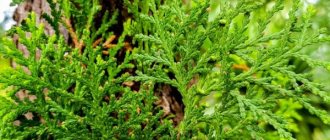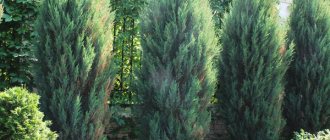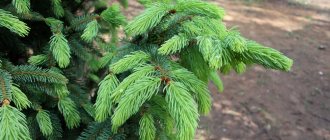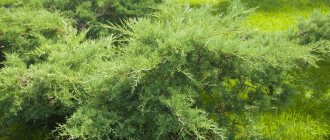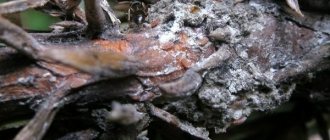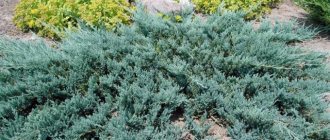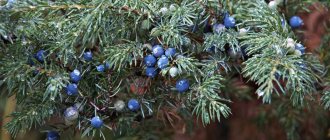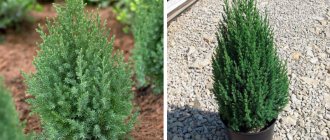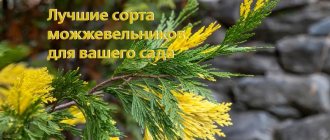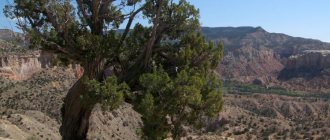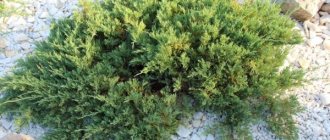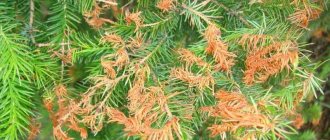Cossack juniper is unpretentious and does well in urban environments. creeping coniferous shrub from the Cypress family is actively used for landscaping the urban environment and creating attractive park areas.
However, given the fact that this conifer is poisonous, planting it along playgrounds is prohibited.
How to plant
Planting Cossack juniper should not pose any particular difficulties even for a novice gardener, since this plant is distinguished by its high adaptive ability.
The main thing is to choose a suitable location with deep groundwater and good drainage capacity of the soil.
Landing dates
By the time of planting, the soil temperature should reach 5 ° C, the soil should be sufficiently dry . You can plant a bush either in mid-spring or in mid-autumn.
Site selection and soil preparation
The requirements for the landing site are very simple:
- The site should be located on a hill to prevent close groundwater.
- The place is well lit, light partial shade is possible only during the midday hours.
- The soil on the site is loose, well-drained, and nutritious.
Note! If nettles grow on the site, then the soil is suitable for juniper. No additional fertilizer is required.
For clay soils, a mandatory step in preparing for planting a juniper bush will be the addition of several buckets of coarse river sand.
Humus and peat are added to depleted soils . The area is well dug up and the roots of weeds are removed before planting juniper.
What can be planted nearby?
Juniper has a peaceful disposition and does not conflict with its neighbors . Its high decorative qualities make it possible to place the bush both in a flower garden and among ornamental shrubs.
However, it is worth considering that Cossack juniper tends to grow in width, so it needs to be planted in a sufficiently large empty space, placing other plants at a distance of at least 1.5 meters.
Landing rules
Before planting in a permanent place, the juniper bush must be prepared. Carefully inspect the plant, cut off all damaged and yellowed shoots, remove stunted roots , etc.
Dissolve the root formation stimulator in a bucket of water and soak the roots in this solution for 2–3 hours.
To plant juniper, you need to follow the sequence of actions:
- The area is dug up in advance, weed roots and large stones are removed.
- Dig a planting hole of such a size that the juniper root ball fits completely into it and there is free space left. A drainage layer of small pebbles or broken bricks must be laid at the bottom.
- A seedling is planted, sprinkling the free space with a mixture of turf soil, peat, humus and sand.
- The planting is compacted and watered abundantly.
- The space around the bush is mulched.
Transfer
Juniper does not need replanting.
A plant that has not reached 10 years of age can still be moved to a new location in exceptional cases (the site is flooded or construction is planned on this site), but an older plant most likely will not tolerate replanting .
The best varieties of Cossack Juniper
There are many varieties of the crop, divided into three main groups: dwarf, medium-sized and tall. Let's look at the most popular ones.
The best dwarf varieties of Cossack Juniper
- 'Arcadia' (Juniperus sabina Arcadia) - Rich green foliage with a lacy texture and semi-spreading growth habit. Loves completely open locations. Excellent for foundation and mass plantings. It has a cushion-shaped crown and creeping branches. Height - no more than 0.4 m, width - almost 2 m. The needles are soft, light green.
- Cossack tamarixolia juniper (Juniperus sabina Tamariscifolia). Dwarf bush, height - no more than 1 m, branches have needle-shaped, bluish needles.
- 'Rockery Gem' is a low-growing Juniper variety with dense branching and attractive grey-green foliage. Grows up to 30 cm in height and 80 cm in width.
Medium-sized varieties of Juniperus sabina (above a meter)
- Variety 'Mas' is a widespread, dense shrub with diagonally ascending branches with drooping shoot tips. Moderate growth rate. Height 1.5-2 m, width 5-7 m.
- M. Cossack Blue Danube (Juniperus sabina Blue danube) - distinguished by branches bent towards the top. The needles are usually scaly in shape and have a bluish-gray tint. Plant height - up to 1.5 m.
- Other medium growing varieties such as 'Tamariscifolia New Blue', 'Hicksii', 'Femina', 'Jade', 'Cupressifolia'
Care
Cossack juniper is an unpretentious crop and does not require specific care. Absolutely anyone can cope with its cultivation.
Watering
Immediately after planting, juniper requires abundant watering, but as it matures, the frequency of watering is sharply reduced. The optimal watering schedule is three times per season .
The bush can be watered additionally if there is no precipitation for more than 15 days and the air temperature is above 25 °C. The shrub responds much better to regular (about once a week) spraying than to watering.
Attention! Water procedures associated with spraying should be carried out only when the sun has gone down, so as not to cause burns on the delicate needles.
Top dressing
If fertilizers were incorporated into the soil during planting, then in the next couple of years, additional fertilizing is not required for the juniper .
After this period, mineral complexes with nitrogen are added annually in the spring with watering, and this is where the fertilizing ends.
Mulching, loosening the soil
Mulching helps reduce weed activity and reduce the percentage of natural moisture evaporation , which means reducing the frequency of watering. You can use ground bark, humus or straw as mulch. Change the layer of mulch in the fall before wintering the plant.
Loosening the soil is a mandatory procedure that allows you to maintain high air permeability of the soil and prevent the formation of a hard crust on its surface. Loosen the tree trunk circle after each watering and precipitation.
Shelter for the winter
Only young plants under 2 years old need to be covered for wintering. Further, the juniper overwinters well even without shelter.
To make wintering easier, autumn water-charging irrigation is carried out , but only under the condition that the autumn is dry and there is no rain. Then remove the old layer of mulch and lay out a new one, paying special attention to the tree trunk circle.
young bushes with spruce branches or straw .
Reproduction
In nature, Cossack juniper spreads through seeds and layering. At home, you can additionally carry out cuttings or grafting. Seed material for propagation is rarely used, since the method takes the longest and does not preserve the varietal characteristics of the plant. If necessary, the seeds must first be subjected to stratification. Grafting is used for elite hybrids, but is also not always justified, since there are simpler methods of reproduction.
It is more often recommended to plant independently formed layerings. When the shoots of Cossack juniper touch the ground, they sprout roots. When they reach normal size, it is enough to simply plant the bush. To root a twig of a variety whose shoots do not spread along the ground, it is enough to bend it down, attach it with wire, periodically hill it up and water the place in contact with the soil.
Cuttings are carried out in the spring or at the end of August - beginning of September. The shoot should be torn off with the heel, and the cut site should be treated with a growth stimulator. Root in a moistened, loose nutrient substrate, deepening it to 3-5 cm. A full-fledged root system will be formed in 2.5-3 months, after which it is transplanted into open ground. It is permissible to grow juniper cuttings in containers for the first 2-3 years.
Pests and diseases
Thanks to the specific smell inherent in the crop, you don’t have to worry about parasite invasions . Insects prefer to attack other plants that do not have such a clear aroma.
Due to improper agricultural practices, juniper may suffer from fungal diseases . If the branches of a shrub turn yellow and dry out en masse, most likely, too much moisture has accumulated in the soil. It is necessary to review the irrigation regime and treat the bush with fungicides.
Description of the plant
Junipers (Juniperus) are evergreen coniferous shrubs and trees of the Cypress family. The shrub usually grows from 2 to 6 m in height. Some varieties are tall trees and form entire forests. Their leaves are small, prickly needles and look similar to pine or spruce.
Juniper is a distant relative of pines and spruces. The plant has a unique ability to heal just by growing nearby. When you inhale the resinous aroma, your soul becomes calm and joyful.
The peculiarity of juniper is that its flowers are unisexual, female, in the form of round greenish cones, and male flowers - in the form of earrings with 3 or 4 stamens. The plant blooms in June and bears fruit from August to September. Juniper fruits - cone berries - contain loose brownish pulp, which is widely used for medicinal purposes.
Appearance of the plant
Juniper is a forest inhabitant of the northern regions. But it is also successfully grown in suburban areas. Indeed, in addition to its medicinal properties and incomparable smell, it is surprisingly effective and can decorate any place.
Application in landscape design
Cossack juniper is actively used in landscaping urban areas and park areas . The shrub also looks great in garden plots, where it is used as a hedge or ornamental bush .
You can see about other plants for decorating a garden plot:
Rose stock: an incredible giant in your garden Petunia Gioconda multiflora: a floral carpet
Answers to frequently asked questions
Question: During the long winter, my juniper suffered greatly. The varieties “Cossack juniper” and Old Gold were planted. They sniffed a lot. Dried and diseased branches were pruned. Now they are a difficult sight. Can they be saved? Answer: What happened to you is a consequence of the fact that the branches were overloaded with snow for a long time. To prevent this from happening, they need to be supported. In some cases it is necessary to tie them with twine, in others - to put supports. It also helps to tighten the branches using tights. Now your trees need to be treated with some kind of fungicide to prevent fungi from appearing.
Question: I have juniper bushes planted densely, about two meters apart. I understand that they need to be cut, but I'm afraid of ruining them. How to do this correctly so as not to damage anything? Answer: I do the following. I choose the most protruding branches and cut them off at their first fork to avoid bald spots. Although I know that professionals simply trim the bushes as needed, without selecting individual branches.
